Peperomia: description, types, reproduction and care

Many indoor plant lovers prefer to grow peperomia, as it is rather unpretentious. This article will tell you more about the species, reproduction and care of this plant.
Peculiarities
South American states are considered the homeland of this plant. All kinds of peperomia grow in the tropical area of this region. So, there are both annuals and perennial specimens. It is noteworthy that the tallest specimens in height can reach more than 50 cm.
The leaves of this plant are usually fleshy, dense. On the upper surface, there may be plant deposits that resemble wax.
This substance is necessary in order to protect the internal environment of the flower from the effects of various adverse environmental factors.

Currently, there are indoor species of this plant. It is quite easy to grow such flowers. Even a novice indoor plant lover can handle peperomia care. Each type of this plant has its own characteristics in the structure of individual elements. For example, plants may vary slightly in leaf shape and size.
The color of the foliage is also different. Leaves are elongated, elliptical or oval. Some specimens have rather small (even miniature) leaves, while others have larger ones. There are different types of such colors and the appearance of the sheet plate. It can be both flat and corrugated.



During flowering, several inflorescences appear on the flower. It is worth noting that they look rather inconspicuous. Each inflorescence consists of several white flowers. The flower is small. Despite such a discreet bloom, peperomia still complements the interior of the room well.
White flowers in combination with fleshy dense leaves create a cozy atmosphere in the house. This houseplant is not poisonous. Therefore, it can be placed not only in the living room, but even in the children's room. The flower needs sufficient sunlight to grow well, as well as regular watering.

Varieties
Experts identify quite a few types of peperomia. Among them there are quite popular ones, which among lovers of indoor plants are in greatest demand.
- One of them is peperomia blunt-leaved... This flower is perennial. It is interesting that this plant can grow not only on the ground, but also on trees. Its leaves are fleshy, dense to the touch. Their dimensions are usually 3-6 cm wide and 9-11 cm long. The surface is corrugated, and the color of the leaves can be different - dark green, cream or white.

- Round-leaved peperomia - one more type. This flower has thin shoots. Its leaves have a deep green color. The shape of the leaves is close to a circle. Experts note that this plant has the ability to grow on the ground, covering it with itself. Because of this property, this variety is used by some landscape designers to create interesting and memorable work.

- Silvery peperomia the room looks pretty impressive. One of the important features of this plant is that its lower leaves are quite close to the ground. The shape of each leaf is oval. Moreover, their tip is slightly pointed.Graceful silvery stripes are located on the outer surface of the leaves, which gives the plant a special appearance.
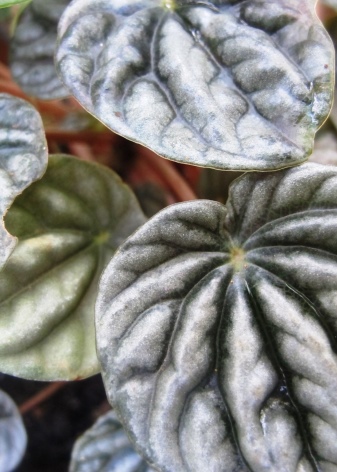

- Heady peperomia "Glabella" refers to ampelous plants. It is characterized by the fact that it has rather long shoots. The leaves are small, oval in shape. Experts note that such a plant is excellent for creating interesting floristic compositions.

- Clusial peperomia - a beautiful ornamental plant. It has rather bright elongated leaves of an elongated shape. The height of such a plant can be about 45 cm. This plant is an upright bush. A unique feature of this species is the color of the leaves in dark green and purple colors. The edging of the leaf is usually light.


- One of the massive types of peperomia is the ampelous species. Such a plant is characterized by the fact that its height can be up to 1.5 meters. In this case, the leaves have a different color. They can also differ in form. There are also very interesting types, for example, "Watermelon"... The flower received this name due to the fact that the color of its leaves resembles a watermelon. So, on each leaf, saturated green and light colors alternate. In this case, the petioles, through which the leaves are attached to the stem of the plant, have a reddish color. Such a flower in the interior looks quite bright and impressive.
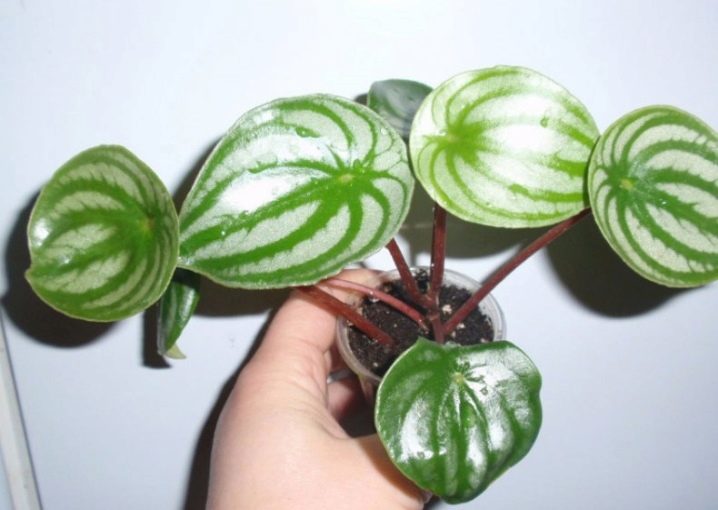
- Variegated peperomia characterized by a special color of the leaves. They are dark green, reddish and beige in color. This flower looks like a bush.
It is the result of the productive work of breeders. Some natural types of peperomia were chosen as the basis for the creation of this type.


- Rosso - another type of this plant. It belongs to the subshrub. A plant grown in indoor conditions, as a rule, has a relatively small height - only 20-24 cm. It is interesting that the leaves attached to the stem grow in bunches. The peculiarity of this plant is also in the special color of the foliage. So, the upper, facing the sun's rays, the surface of the leaf has a rich bright green color, and the lower one is reddish.


- Another decorative type is Ferreira's peperomia... Its leaves look as if they have grown together in the center. The length of each leaf is small - only 6-7 cm. Their color is bright green. This plant can have a height of about 27-30 cm. The leaves of such peperomia are quite dense, it requires proper watering. If the leaves are very dusty, then they can be periodically sprayed from a spray bottle.

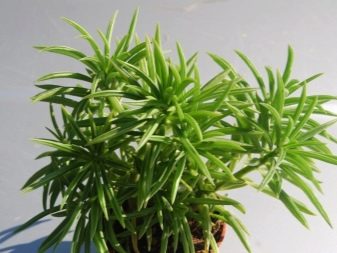
- "Graveolens" - succulent peperomia, which has a very bright appearance. Nature has awarded the flower with very beautiful leaves that will certainly attract attention. Their upper surface is light green, and the lower one is burgundy and even ruby. In this case, the leaves grow in such a way that they twist to the main shoot. Some indoor plant lovers note that this flower can be compared with a coral in its appearance. At the same time, even greater similarity with a marine life can be achieved if the soil in which the flower is planted is covered with pebbles.

- "Polybotria" characterized by rather large leaves. Their color is deep green. The leaves are rounded, but sharpen towards the ends. The flower has a rather dense shoot, to which the leaves are attached.

- Whorled peperomia refers to perennial plants. The color of its leaves is gray-green. This plant got its name due to the peculiarities of the attachment of the leaves to the shoot. Experts note that this flower is best propagated through cuttings.


- Peresky peperomia characterized by the presence of small leaves. In length, they usually do not exceed 5 cm, and in width - 3 cm. The shape is elliptical or diamond-shaped. At the same time, they are quite dense to the touch.Interestingly, close relatives of this flower grow in Venezuela, Colombia and Peru.

- Variegated peperomia the interior looks very impressive.
Indoor plant lovers should remember that this species is quite picky about light. Insufficient lighting can cause various diseases of the flower, which will lead to poor growth.
It is recommended to place such a plant in fairly light rooms, closer to a natural light source.



- Large-leaved peperomia is a species that is often used in landscape design. The grown bush of this plant in its appearance resembles a soft pillow. Its leaves have a rich green color and a rounded shape. If you look at the plant from some distance, you can see a beautiful metallic sheen on the leaves.

Specialists in the care of indoor plants recommend that when buying, be sure to pay attention to a specific species. Quite popular types include: "Green Gold", "Ferreira", "Tupolistnaya", "Variegatnaya", "Glabella", "Whorled", as well as various mix of varieties.
Quite simply, at home for novice indoor plant lovers, it will take care of round-leaved peperomia.

Growing conditions
Peperomia refers to indoor plants that are rather picky. However, in order for this flower to grow well and delight its owners with a beautiful color of leaves, it requires certain microclimatic conditions. When creating them, experts recommend that you take into account the type of flower.
Lighting
When creating the most favorable conditions for plant growth, it is imperative to focus on the original natural habitats. Peperomia is a resident of predominantly tropical regions. But at the same time, this plant prefers to grow in places with diffused sunlight. Strong sun exposure can be a damaging factor for this flower.
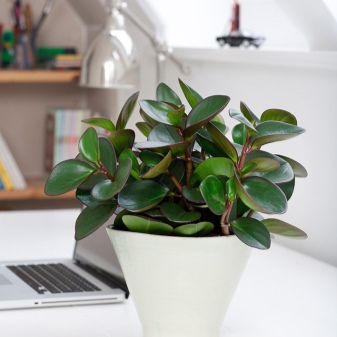
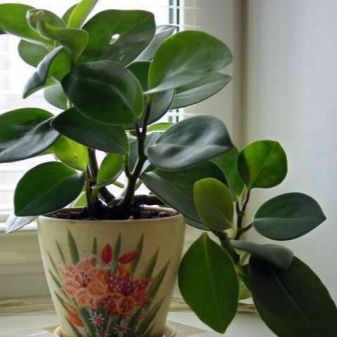
It is important to remember that prolonged contact with the sun can cause specific spots to appear on the leaves of the plant.
They look like discolored areas. So, the leaf can lose its beautiful natural dark green color and become lighter. Such sunburns with improperly selected lighting for a flower can appear on several of its leaves at once.
In order for the plant to grow well, it is recommended to create calmer conditions during the daytime. - for example, remove from a window sill, which is brightly lit, to another place. In order that the flower does not need to be constantly transferred from place to place, it should be immediately placed in that area of the apartment where the lighting is sufficient, but not too bright. Some experts in the care of such flowers recommend placing peperomia not on windowsills, but at a short distance from them.



It is worth noting that some types of flowers are more demanding on light. These include, for example, variegated specimens. For the purpose of adequate growth, they can also be placed on the windowsill. Quite often, variegated specimens are also placed on the shelves of cabinets inside the room. With this placement, experts recommend that you be sure to monitor the condition of the flower. If its leaves begin to fade, then the plant should be urgently moved to a brighter place.
For light-sensitive peperomias, additional illumination can be created in autumn and winter.

Experts recommend doing this, if possible, from mid-October to the end of February. At this time, the length of daylight hours decreases. The flower, for its good growth, requires at least 15-16 hours of light on the leaves.
Temperature and humidity
Peperomia is a plant that, when growing, does not require a constant change in temperature.Therefore, it is recommended to maintain the selected temperature, if possible, throughout the entire calendar year. Even in winter, it does not need to be specially changed.
The flower is unpretentious and grows well at temperatures around 22-24 degrees. However, even when the temperature drops to 20 degrees, it does not lag behind in its growth. Experts advise that you should not allow too much change in the temperature in the room where the plant is located. So, if the temperature in the room for some reason during the winter period drops to 14-15 degrees, then the plant can simply get sick.
In order to avoid adverse consequences in the event that the temperature in the room decreases, it is imperative to move the flower to more favorable conditions. So, peperomia must be urgently removed from the cold windowsill.
Experts recommend to put a special lining under the flower pot in winter, which has heat-insulating properties.

Peperomia adapts fairly well to small changes in indoor humidity. However, with a strong decrease in this indicator, flower growth can slow down significantly. To maintain optimum humidity, experts recommend, for example, sprinkling the pebbles that cover the ground with water. If the humidity in the room is slightly increased, then, according to the opinions of many experts, the vital activity of the plant will not be disturbed in any way.
Transfer
Peperomia after transplantation usually feels pretty good. The flower does not worsen its condition only if the transplant was performed correctly. Before moving the plant to another pot, you should determine its original age. Young specimens can be replanted once a year. More adults - once every 3 years.
Many lovers of home plants are interested in the question of how you can independently understand at what time the flower should be transplanted. To do this, you should pay attention to the drainage holes at the bottom of the flower pot, where the peperomia is located.
If the roots of the plant are already beginning to break through and come out of such a hole, then the flower can be transplanted into a larger pot. Pottery pots work well for this.

Choose a container for a flower, taking into account the size of the plant. Elongated pots are suitable for most peperomias. Since this flower does not tolerate the accumulation of moisture at the roots quite well, expanded clay should be poured onto the bottom of the container where it will be transplanted. The thickness of this layer should be approximately 2-2.5 cm.
The soil substrate is essential for good plant growth. If the soil was selected incorrectly, then peperomia will not be able to properly please the eye of its owners with spectacular green leaves. In order to make a good soil substrate, experts recommend mixing humus, peat and sand in approximately equal proportions. Leafy earth can also be added to this mixture - about 2-3 parts.
For those who want to significantly save their time, soil for growing a flower can be purchased at a special store. In such a ready-made soil substrate, all the components required for good plant growth are already present. After the flower is transplanted into a new pot, it should not be watered for several days.
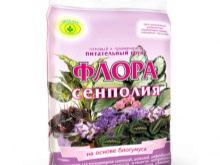


How to properly transplant peperomia is in the next video.
How to care?
Even a beginner can handle the care of this spectacular plant. At home, you should definitely monitor the condition of the leaves. Also, in some cases, this plant must be fertilized with special components for active growth. An important condition for the good life of the flower is regular watering.
Top dressing
Enriching the plant with nutrients helps to improve its growth.In order to feed your pet, experts recommend using complex preparations. They contain several components at once that have a beneficial effect on plant growth.


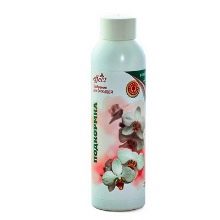
It is recommended to feed the plant in the spring and summer, when it is actively growing. At the same time, you should not use the tool too often, as this can lead to the opposite effect. Therefore, such a complex remedy is recommended to be used no more often than once every 2 weeks. If such a drug is used in the winter, then it should be used no more than once a month.
Watering
Water this flower regularly. At the same time, experts recommend not to forget about this simple procedure, since otherwise the plant will no longer be able to delight its owners with beautiful fleshy leaves. If the leaves have lost in volume, and to the touch they have become not as elastic as before, then this is a reason to improve watering.
Since the plant has no dormant periods in its life, it should be watered throughout the year. The amount of moisture required by a flower is determined taking into account many factors. These include not only the size of the plant, its type, but also the indicators of the indoor microclimate.
For example, in the warmer season, the flower needs more active and abundant watering. In winter, watering should be moderate.

Often, many indoor plant lovers have a question about what will happen to this plant if they forget to water it in a timely manner for some reason. Experts note that no serious adverse consequences will follow. However, it is also recommended not to forget that this plant does not tolerate drought quite well.
Watering the soil should be done carefully. Excessive accumulation of water in the soil should be avoided when watering. The accumulation of water (especially frequent) can cause various diseases of the root system. This, as a rule, negatively affects the growth and life of the flower. Therefore, after moderate watering, the plant should be thoroughly dried. To do this, you should wait a few days. Too frequent and abundant watering of peperomia is not required.
Water quality is important when watering a given plant. Experts note that if hard water is used for irrigation, this can damage the root system of the flower. It is better to water the home beauty with water that has been previously settled. It is possible, if possible, to use filtered water for irrigation. Some plant care specialists recommend watering this plant with melt water. They recommend doing this procedure periodically.

Reproduction
There are different ways of propagating peperomia. The first is seeds. At the same time, experts recommend buying them only from trusted manufacturers. The type of flower must be indicated on the package with seeds. According to many home plant lovers, this method of plant propagation is rather complicated. Even with proper seed care, it is not always possible to get a beautiful and healthy plant. That is why novice gardeners are advised to choose alternative growing methods.
This flower also propagates through cuttings. At the same time, cuttings can be harvested during the active growing season of the plant. First, you should determine the top of the cutting so that there is a single knot on it, and then cut it off. After this, the future shoot of the plant should be transplanted into the ground.

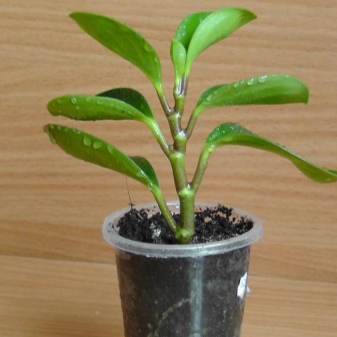
The formation of the root system and the further strengthening of the flower in the soil occurs, as a rule, a month after planting.
In order for the cutting to take root in the nutrient soil, it needs a certain temperature - about 24-25 degrees. Experts note that if the temperature drops below 10 degrees, the transplanted stalk may die.Therefore, after grafting and planting in the ground, it is imperative to control the ambient temperature in the room.
Peperomia can also be propagated with leaves. In this case, almost the same principle is used as for grafting. For propagation, it is recommended to choose a mature leaf with a small cuttings. In this case, you should also carefully monitor the air temperature in the room, as with cuttings. After the young plant grows up and gets stronger, it can be transplanted into another pot. Experts do not advise to rush with this. First, it is recommended to wait for the formation of a full root system and a set of leaves.

Diseases and pests
Since peperomia is quite resistant to the effects of various adverse conditions, it rarely gets sick. However, improper care of a flower can cause it to develop specific diseases. Often, too frequent or excessive watering in intensity leads to diseases of this plant. Stagnation of water in the soil contributes to the disruption of the functioning of the root part of the plant, which leads to the development of diseases. Also, in constantly moist nutrient soil, microbes often accumulate, which can provoke dangerous plant diseases.
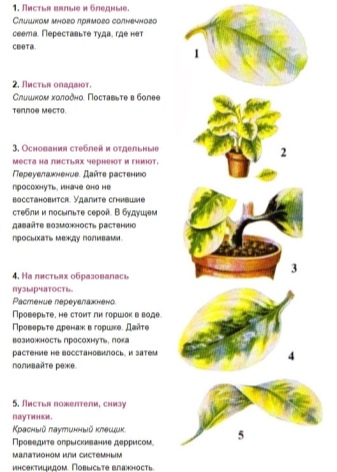

In order to timely identify any deterioration in the life of a flower, experts recommend that you must monitor the condition of its leaves. Changes in color, the appearance of any spots on the leaves or their strong fall are warning signs. If such symptoms appear, then the plant should be urgently treated. In this case, you should definitely pay attention to how the flower was previously taken care of - whether there was too frequent watering, and whether the plant was in a sufficiently lit place.


There are several pests that can harm this plant. So, the most frequently recorded are the following: worms, spider mites, nematodes, scale insects and thrips. Many such parasites are not detected in time, as they often hide on the back surface of the leaves. That is why experts in the care of indoor plants recommend that you periodically check the leaves for discoloration or the appearance of any dark areas or powdery plaque.


For the preventive purpose of the development of diseases and even treatment, various means can be used. So, some people, in order to protect their peperomia from pests, treat them with tobacco infusion or a solution containing laundry soap. However, such folk methods, unfortunately, do not always help to cope with parasites that can harm the flower.
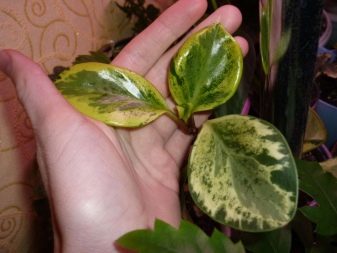

If with the help of such preparations it was not possible to clear the leaves of pests, you can also use ready-made products with fungicidal properties. During the treatment, it is imperative to slightly reduce watering, and also avoid overcrowding of plants and do not forget about good ventilation in the room. If several plants are placed on the windowsill at once, then the diseased flower should be removed from them. Such a forced quarantine measure will help protect other flowers from infection.









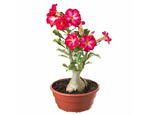




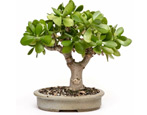




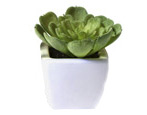








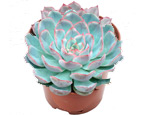























The comment was sent successfully.